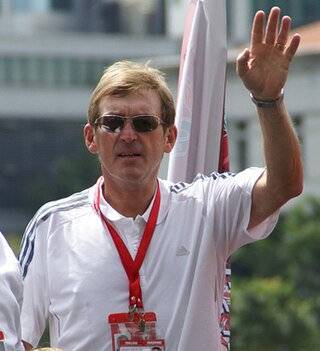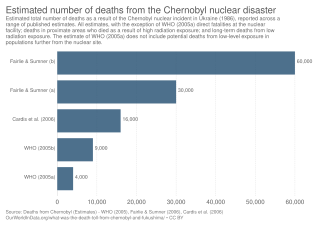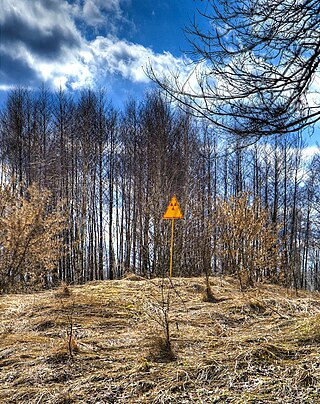The topic of this article may not meet Wikipedia's notability guideline for biographies .(March 2024) |
James Kenny is a professional photographer based in the United Kingdom.[ citation needed ]
The topic of this article may not meet Wikipedia's notability guideline for biographies .(March 2024) |
James Kenny is a professional photographer based in the United Kingdom.[ citation needed ]
Kenny was born and raised in Cambridgeshire, where he studied Photography and Journalism with the intention of becoming an automotive journalist. [1]
One of Kenny's projects looked into the legacy of the Chernobyl disaster, where he photographed orphans in Gomel, Belarus affected by the radioactive pollution. Kenny visited the orphanages with nine bikers who were raising money for The Chernobyl Children's Project. [2]

Chernobyl or Chornobyl is a partially abandoned city in the Chernobyl Exclusion Zone, situated in the Vyshhorod Raion of northern Kyiv Oblast, Ukraine. Chernobyl is about 90 kilometres (60 mi) north of Kyiv, and 160 kilometres (100 mi) southwest of the Belarusian city of Gomel. Before its evacuation, the city had about 14,000 residents. While living anywhere within the Chernobyl Exclusion Zone is technically illegal today, authorities tolerate those who choose to live within some of the less irradiated areas, and around 1,000 people live in Chernobyl today.

Sir Kenneth Mathieson Dalglish is a Scottish former football player and manager. He is regarded as one of the greatest players of all time as well as one of Liverpool's and Britain's greatest ever players. During his career, he made 338 appearances for Celtic and 515 for Liverpool, playing as a forward, and earned a record 102 caps for the Scotland national team, scoring 30 goals, also a joint record. Dalglish won the Ballon d'Or Silver Award in 1983, the PFA Players' Player of the Year in 1983, and the FWA Footballer of the Year in 1979 and 1983. In 2009, FourFourTwo magazine named Dalglish the greatest striker in post-war British football, and he has been inducted into both the Scottish and English Football Halls of Fame. He is very highly regarded by Liverpool fans, who still affectionately refer to him as King Kenny, and in 2006 voted him top of the fans' poll "100 Players Who Shook the Kop".

A nuclear and radiation accident is defined by the International Atomic Energy Agency (IAEA) as "an event that has led to significant consequences to people, the environment or the facility." Examples include lethal effects to individuals, large radioactivity release to the environment, reactor core melt." The prime example of a "major nuclear accident" is one in which a reactor core is damaged and significant amounts of radioactive isotopes are released, such as in the Chernobyl disaster in 1986 and Fukushima nuclear disaster in 2011.

Pripyat, also known as Prypiat, is an abandoned city in northern Ukraine, located near the border with Belarus. Named after the nearby river, Pripyat, it was founded on 4 February 1970 as the ninth atomgrad to serve the nearby Chernobyl Nuclear Power Plant, which is located in the adjacent ghost city of Chernobyl. Pripyat was officially proclaimed a city in 1979 and had grown to a population of 49,360 by the time it was evacuated on the afternoon of 27 April 1986, one day after the Chernobyl disaster.

The Chernobyl Nuclear Power Plant Zone of Alienation is an officially designated exclusion zone around the site of the Chernobyl nuclear reactor disaster. It is also commonly known as the Chernobyl Exclusion Zone, the 30-Kilometre Zone, or The Zone.

The Chernobyl Nuclear Power Plant is a nuclear power plant undergoing decommissioning. ChNPP is located near the abandoned city of Pripyat in northern Ukraine, 16.5 kilometers (10 mi) northwest of the city of Chernobyl, 16 kilometers (10 mi) from the Belarus–Ukraine border, and about 100 kilometers (62 mi) north of Kyiv. The plant was cooled by an engineered pond, fed by the Pripyat River about 5 kilometers (3 mi) northwest from its juncture with the Dnieper.
Adi Marie Roche is an Irish activist, anti-nuclear advocate, and campaigner for peace, humanitarian aid and education.

The Chernobyl disaster began on 26 April 1986 with the explosion of the No. 4 reactor of the Chernobyl Nuclear Power Plant, near the city of Pripyat in the north of the Ukrainian SSR, close to the border with the Byelorussian SSR, in the Soviet Union. It is one of only two nuclear energy accidents rated at seven—the maximum severity—on the International Nuclear Event Scale, the other being the 2011 Fukushima nuclear accident in Japan. The initial emergency response and subsequent mitigation efforts involved more than 500,000 personnel and cost an estimated 18 billion roubles—roughly US$68 billion in 2019, adjusted for inflation. It is considered the worst nuclear disaster in history.

The New Safe Confinement is a structure put in place in 2016 to confine the remains of the number 4 reactor unit at the Chernobyl Nuclear Power Plant, in Ukraine, which was destroyed during the Chernobyl disaster in 1986. The structure also encloses the temporary Shelter Structure (sarcophagus) that was built around the reactor immediately after the disaster. The New Safe Confinement is designed to prevent the release of radioactive contaminants, protect the reactor from external influence, facilitate the disassembly and decommissioning of the reactor, and prevent water intrusion.

The 1986 Chernobyl disaster triggered the release of radioactive contamination into the atmosphere in the form of both particulate and gaseous radioisotopes. As of 2022, it was the world's largest known release of radioactivity into the environment.
The Chernobyl disaster is the world's worst nuclear accident to date.

Anatoly Stepanovich Dyatlov was a Soviet engineer who was the deputy chief engineer for the Chernobyl Nuclear Power Plant. He supervised the safety test, which resulted in the 1986 Chernobyl disaster, for which he served time in prison as he was blamed for not following the safety protocols. He was released due to health concerns in 1990.

The Red Forest is the ten-square-kilometre (4 sq mi) area surrounding the Chernobyl Nuclear Power Plant within the Exclusion Zone, located in Polesia. The name "Red Forest" comes from the ginger-brown colour of the pine trees after they died following the absorption of high levels of ionizing radiation as a consequence of the Chernobyl nuclear disaster on 26 April 1986. The site remains one of the most contaminated areas in the world today.
Gerd Ludwig is a German-American documentary photographer and photojournalist.

Alexander Yukhymovych Sirota is a Ukrainian photographer, journalist, filmmaker. He writes in Russian and Ukrainian. As a former resident of Pripyat, he is an eyewitness and a victim of the 1986 Chernobyl disaster. He has devoted many articles, photographs, and video reports to the city of Pripyat and to the Chernobyl catastrophe. He is the editor-in-chief of the internet project "pripyat.com" and the president of the International Public Organization "Center Pripyat.com". In May 2008, he became the winner of the ІХ-th international competition "Golden George" of films, TV-programs, and internet projects about protective law and law enforcement. In that competition, Alexander won "The Big Tape of George" award for his website devoted to Chernobyl. He is a member of the Union of Journalists of Ukraine since 2008 and a member if International Federation of Journalists.
The Chernobyl disaster, considered the worst nuclear disaster in history, occurred on 26 April 1986 at the Chernobyl Nuclear Power Plant in the Ukrainian Soviet Socialist Republic, then part of the Soviet Union, now in Ukraine. From 1986 onward, the total death toll of the disaster has lacked consensus; as peer-reviewed medical journal The Lancet and other sources have noted, it remains contested. There is consensus that a total of approximately 30 people died from immediate blast trauma and acute radiation syndrome (ARS) in the seconds to months after the disaster, respectively, with 60 in total in the decades since, inclusive of later radiation induced cancer. However, there is considerable debate concerning the accurate number of projected deaths that have yet to occur due to the disaster's long-term health effects; long-term death estimates range from up to 4,000 for the most exposed people of Ukraine, Belarus, and Russia, to 16,000 cases in total for all those exposed on the entire continent of Europe, with figures as high as 60,000 when including the relatively minor effects around the globe. Such numbers are based on the heavily contested linear no-threshold model.
John Paul Fusco was an American photojournalist. Fusco is known in particular for his photographs of Robert F. Kennedy's funeral train, the 1966 Delano Grape strike and the human toll of the Chernobyl nuclear disaster. Fusco began his career as a photographer for Look magazine, and was a member of Magnum Photos from 1973 until his death in 2020.
Michael Forster Rothbart is an American photojournalist. He is best known for his work documenting the human impact of nuclear disasters.